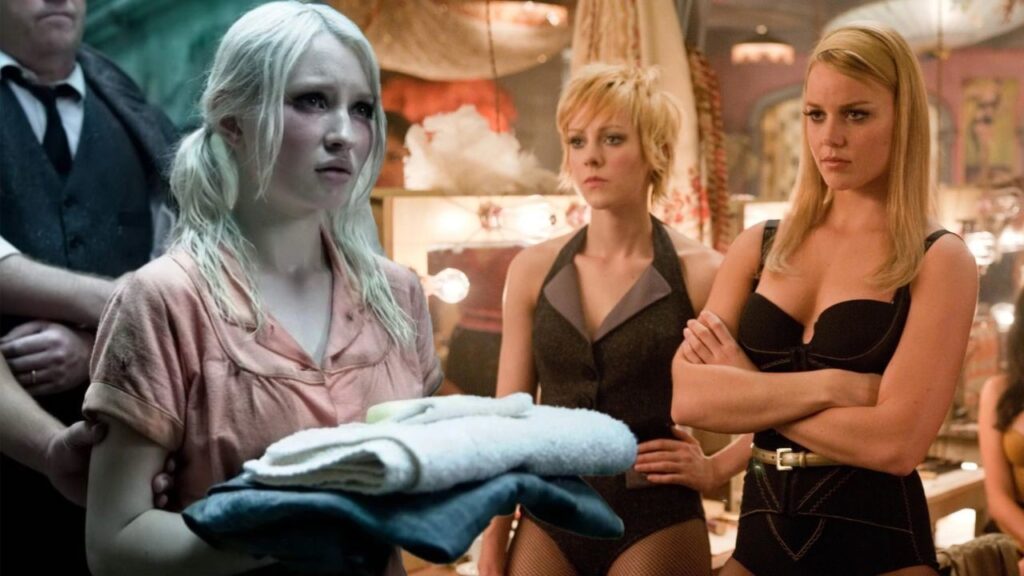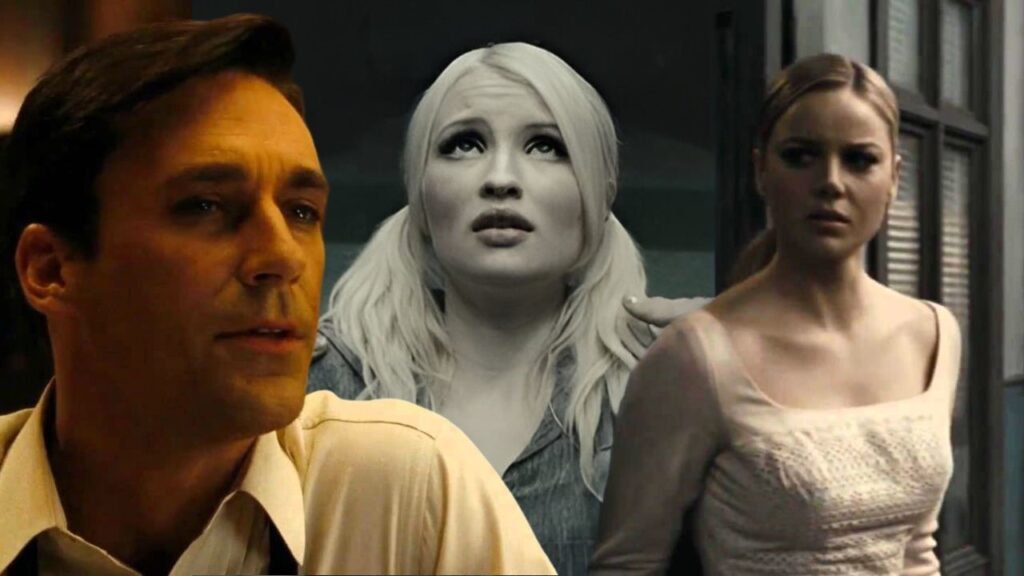This post includes a brief plot explanation, an analysis and a review of the 2011 film “Sucker Punch”. Beware of spoilers.

What if your mind was your only escape? In Zack Snyder’s visually stunning yet controversial 2011 film Sucker Punch, reality blurs with fantasy as a young woman fights for her freedom through layers of imagination.
This visually arresting spectacle, featuring Emily Browning, Abbie Cornish, and Vanessa Hudgens, weaves together multiple realities as it explores themes of trauma, escape, and empowerment through a controversial lens.
Note: This is not a first-time watch review but rather a revisiting of “Sucker Punch” (2011).
“Sucker Punch” is about a young girl, Babydoll, who is sent to a mental institution by her abusive stepfather after she accidentally shot her little sister.
Babydoll has only five days to escape her fate, a lobotomy. To cope with hard times, Babydoll mentally transports herself into a different reality. This place is a high-end brothel, which mirrors what is going on or will go on in the mental institution.
Together with four other young women (Rocket, Blondie, Amber and Sweet Pea), Babydoll plots her escape. In her fantasy, a mysterious figure, Wise Man, guides her through the process. If Babydoll wants to achieve freedom, she will need: a map, fire, a knife, a key and a fifth object that will reveal itself when the time is right.
Whenever Babydoll enters into a mission, her mind takes her to a fantastical world. Together with her fighting comrades, Babydoll faces various different challenges, including battling samurais, zombie soldiers and a dragon.
But things eventually start to go sour for the ladies when Blue, the man who controls them, finds out about their escape plans. Rocket dies while protecting the girls, while Amber and Blondie are brutally murdered by Blue.
At this point, only Babydoll and Sweet Pea are carrying on with the escape plan. Nonetheless, only one of them will be able to escape. In a final act of bravery, Babydoll creates a diversion and surrenders herself to her captors, so Sweet Pea could escape.
The film ends with Babydoll back in her current reality, going through the lobotomy. Those who wronged her eventually receive their punishment too. Meanwhile, Sweet Pea is shown onboarding a bus, suggesting that she successfully escaped the mental institution with hopes of starting a new life.
“Sucker Punch” is a film that attempts to empower women and critique objectification. Nonetheless, many criticize the film for falling into the same problem it tries to expose.
Throughout the film, the audience witnesses the main leads, young women, trying to escape an extremely exploitative and oppressive environment. That premise alone is quite empowering, because it shows that they are willing to fight for themselves in order to reconquer their freedom.
Nevertheless, even in an alternative reality, these women can’t free themselves from the male gaze. Zack Snyder presents his heroines in an extremely “pretty package”: tight clothes and sexy makeup. So, even when they fight, strategize and lead, they need to look good while doing all these things.
Zack Snyder’s view on gender dynamics in the film is actually quite gloomy. It seems that no matter how hard the women fight, it’s hard to escape their fate.
Regardless of Zack Snyder’s intention regarding the objectification of his female leads, story-wise everything will lead to the same place. It’s difficult to beat the beast that “systemic misogyny” is, and those who try to do it will eventually be punished for it. In other words, there is no solution or escape.
Note: These are not my thoughts, but ultimately it seems that Zack Snyder’s original intention of promoting “female empowerment” with “Sucker Punch” failed. The premise was good, but the execution fell short.
Whether the ladies in “Sucker Punch” are at the mental institution or in an alternative reality, such as a high-end brothel, the outcome will always be the same: death or eternal suffering. This realization leads to another important question: where is the female empowerment in “Sucker Punch”?
The film blends multiple genres, including action, fantasy, steampunk and psychological drama.
Zack Snyder deserves applause for truly trying to make something “out of the box”. But mixing very different genres altogether just for the sake of it might not always be the best choice. Each mission, individually, was a feast for the eyes but didn’t add much to the overall narrative.
The samurai temple scene marks the beginning of Babydoll’s journey to escape her dooming reality. Meanwhile, the steampunk-inspired World War I battle reaffirms her desire to fight against oppressive structures. Lastly, the battle of dragons was her last mission with her fighting comrades.
Underneath all the action, explosions and fights, “Sucker Punch” is mainly a psychological drama. It’s all about escaping past demons and oppression. The dual narrative was a medium to illustrate what the young women were going through at the mental institution. Just like in the brothel alternative reality, they were being exploited: for profit and for others’ personal pleasure.

Zack Snyder’s “Sucker Punch” reaches its climax with an unsatisfying and nonsensical ending that offers no closure for the long journey of its heroine.
In both realities, Babydoll loses. In the mental institution reality, Blue Jones falsifies Dr. Vera Gorski’s signature and submits Babydoll to a lobotomy. Meanwhile, in the brothel reality, Babydoll sacrifices herself so Sweet Pea could escape.
After the lobotomy, Babydoll became a “vegetable” but a happy one. In a way, the procedure allowed Baby to free herself from the guilt of accidentally killing her little sister. The same goes for the alternative reality, sacrificing herself for Sweet Pea was an act of redemption for Babydoll.
Despite Zack Snyder’s attempt to give a “deep” meaning to Babydoll’s actions, the turn of events doesn’t make any sense because Sweet Pea is not the leading character in “Sucker Punch”, Babydoll is. Also, the lobotomy didn’t do any justice to Babydoll’s fighting spirit.
The ending that Zack Snyder designed for “Sucker Punch” leaves a very bitter taste in the audience’s month. Despite all sacrifices, very little was achieved at the end, which doesn’t complement well with the “girl power” message that the director tries so hard to convey.
Final Thoughts
Despite everything that I said before, I don’t hate nor dislike “Sucker Punch”. I just feel disappointed because it could’ve been so much better. Personally, I believe it would’ve been fine if the alternative reality were confined to the brothel.
The high-tension environment and abuse that the leading ladies were dealing with at the brothel were enough to illustrate the horrors that they were going through at the mental institution. But I guess, without all the hyper-stylized action scenes, it wouldn’t be a Zack Snyder film.
Performance-wise, the male actors outshined the female actors. And this is sort of ironic because the story is about the ladies, but the men totally steal the show with the little time they have on screen. Oscar Isaac delivers a very strong performance as the despicable and menacing Blue Jones. And Jon Hamm captivates the audience with his mysterious role as the High Roller.
Overall, “Sucker Punch” excels visually but fails to make the audience care for the main characters or the whole story itself. The premise is intriguing, only to be let down by an inadequate ending. Such a shame.


